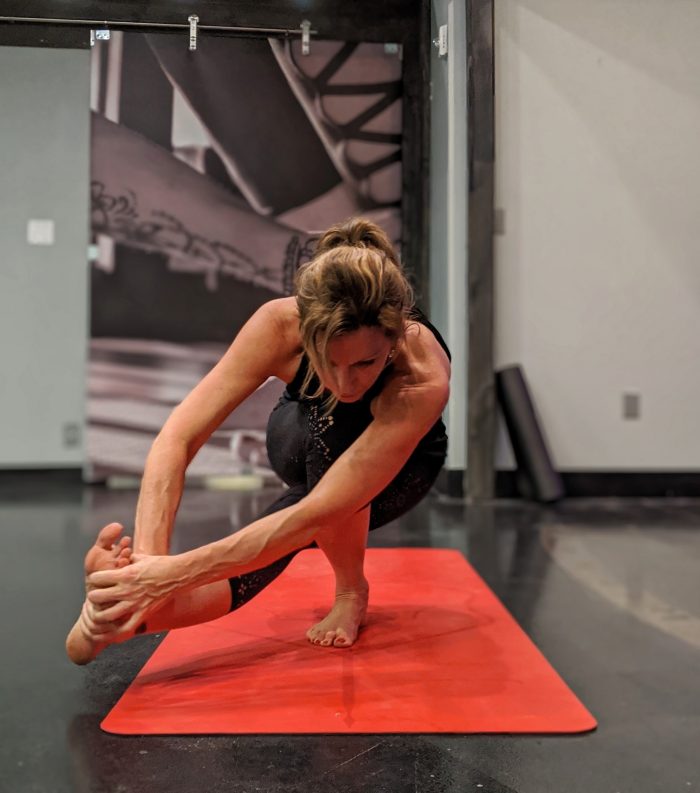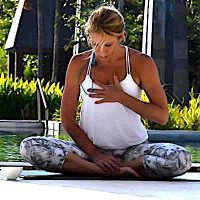This picture evokes such intense feelings.
I study it closer. It’s a picture of me, doing yoga. I marvel at the strong lines of the body in the picture. I have to actively remind myself that it is me. It makes my eyes water and my lip tremble. You would have to be acquainted with the story, the journey, the struggle, and the flow to understand.
Five years ago, I was in a wheelchair: complete right bilateral paralysis, after a massive hemorrhagic stroke (from fear and stress). My ability to speak, read, write, understand language, process time, communicate, move, and think was severely compromised. I was peaceful and terrified at the same time. (Brain injury survivors will know exactly what I mean.)
Yet, here I am. Moving, balancing, talking, walking, and writing. Our bodies are so incredibly intelligent. Our bodies are so much more than resistant. They are antifragile, if given permission. (If you don’t know the definition of antifragile, look it up; there are amazing scientific studies that are so educational.)
I look at the picture again. I try to reconcile the image with me. There is a disconnect.
Let me tell you what you can’t see in the picture:
I’m balancing on my right leg, which is a feat in itself as about one third of the sole of my foot is still numb, yet I feel incredibly connected through my mat to the earth.
My breath is the only thing that I can hear, and that feels real.
I can feel the beads of sweat rolling slowly down my face—except on the lower half of my right cheek, which has no feeling at all.
My stabilizer muscles in my hip and shoulder on the right side do not fire, so the compensation happening in my body is like a symphony. I can feel the surrounding muscle groups standing at full attention, supporting their section.
I have no spacial awareness on my right side of my body, so looking at my right arm floating in front of me feels like a 3D movie.
The voice of my teacher, Jonas Park, is calm and steady. He says I can do it. I believe him. I am trusting us both.
My heart is beating with brave intention.
My mind is quiet—it is my private sanctuary.
I look at the grip in my right hand. The veins are popping, so it must be working hard. That is my only indication, as it is numb and usually heavy. But at that very moment, it is light, capable, and purposeful.
What you can’t see in the picture is the gratitude my chest is exploding with. What you can’t see in the picture are the insurmountable odds that were against me. What you can’t see in the picture are the oceans of tears shed. What you can’t see in the picture are all the non-glamorous moments of victory. Like the first time I could grip a small plastic measuring cup and hold it for three seconds at my mom’s dining room table in the mountains of Montana; my mom and sister cheered like I had won the Olympics. They are heroes. Truly.
What you can’t see are the moments of recovery: so tiny and insignificant. What you can’t see in the picture is the struggle to keep showing up, again and again and again, despite the fear, despite the grief, despite the exhaustion, defeat, and frustration.
I intended to write about what I could see in the picture, but the words elude me. I can’t connect to it fully yet. It all comes in time.
I read this passage and ponder:
”Fearlessness may be a gift but perhaps more precious is the courage acquired through endeavor, courage that comes from cultivating the habit of refusing to let fear dictate one’s actions, courage that could be described as ‘grace under pressure’—grace which is renewed repeatedly in the face of harsh, unremitting pressure.” ~ Aung San Suu Kyi
I have no idea what fearlessness feels like, but I do know what commitment to showing up, even when you absolutely don’t want to, feels like.
So, stay with me. Come here with me. Let’s keep showing up together.











Read 43 comments and reply